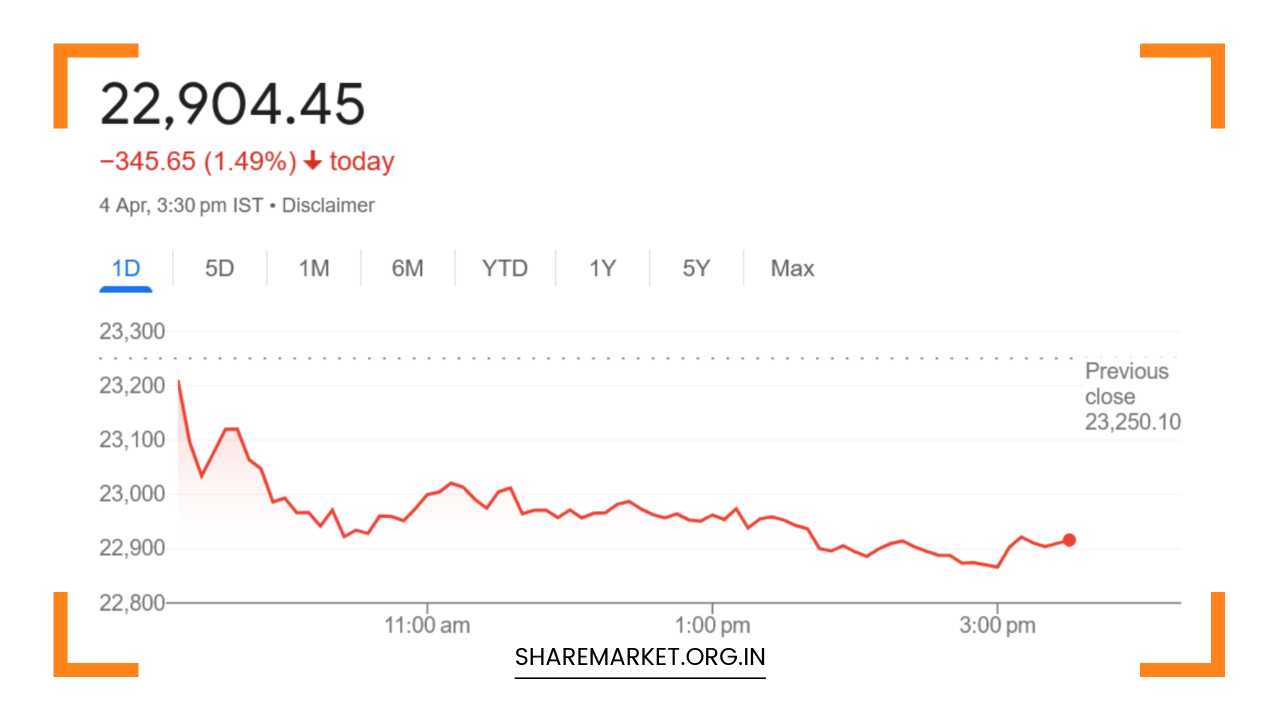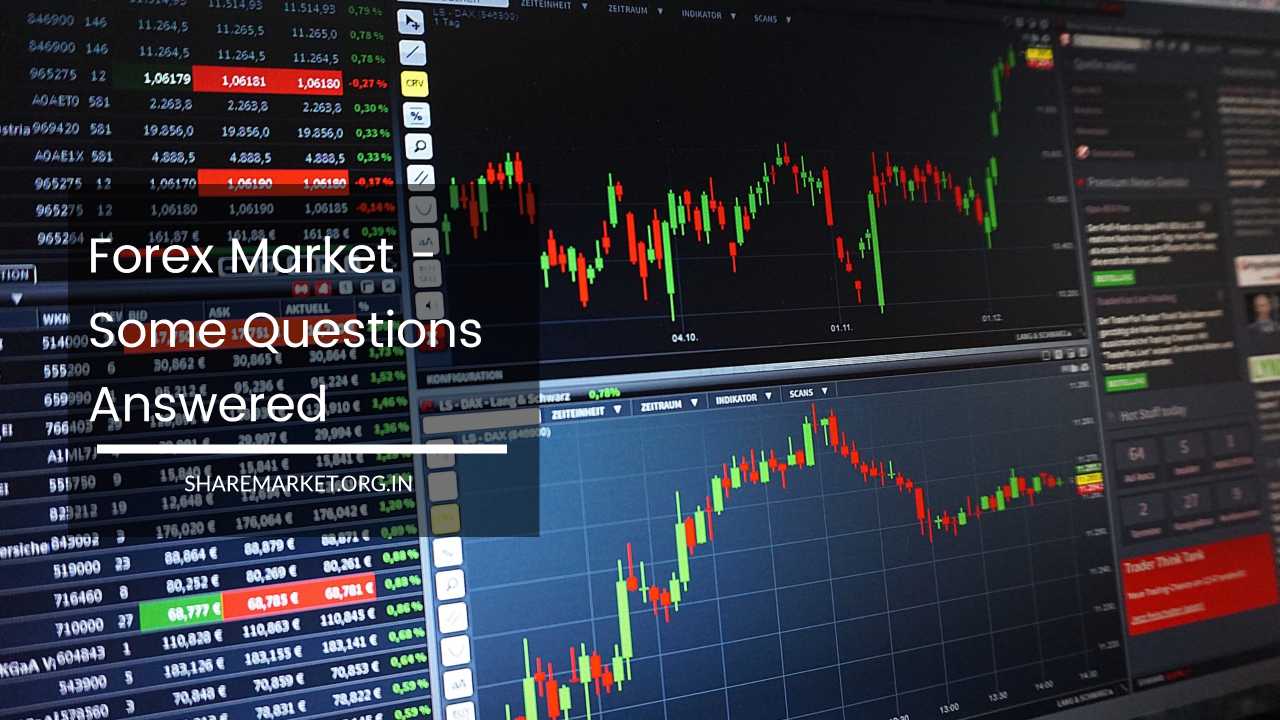Sensex Down 930 Points, Nifty at 22,904; Nifty Prediction for Monday

Nifty Prediction for Monday
Market Closes with a Significant Decline: What to Expect on April 7
The Indian stock market endured a heavy setback on April 4, with major indices seeing a sharp decline as investors reacted to a series of troubling global and domestic developments.
The market’s downturn was primarily driven by growing concerns over geopolitical tensions, the potential for retaliation against the United States, and an increasingly uncertain economic outlook.
These factors, coupled with fears of a looming global recession, led to a significant pullback in investor sentiment, particularly within the metal, oil, and pharma sectors.
Additionally, US bond yields and oil prices have continued to show signs of downward pressure, reflecting mounting concerns about the global economy’s future trajectory.
Stock Market Overview:
On April 4, Indian equity indices were hammered by broad-based selling across multiple sectors. The Nifty50, which tracks the country’s leading 50 companies, closed significantly below the critical 23,000 mark, signaling a momentous shift in investor sentiment.
At the closing bell, the Sensex, a key benchmark index representing the 30 largest listed companies, ended the day at 75,364.69, down by 930.67 points or 1.22%.
Similarly, the Nifty50 closed at 22,904.45, shedding 345.65 points or 1.49%. This marked one of the most significant declines in recent trading sessions, reflecting widespread concerns over both domestic and international factors.
On the broader market front, the sell-off was even more pronounced. The BSE Midcap index fell by 3%, while the BSE Smallcap index declined by 3.4%.
These figures demonstrate that the pressure was not confined to large-cap stocks; it was felt across all segments of the market, indicating a general bearish sentiment that extended beyond just the index-heavy stocks.
Sector Performance:
The sectoral performance on April 4 was overwhelmingly negative, with metal stocks taking the biggest hit.
The Nifty Metal index, which tracks the performance of metal and mining companies, plummeted by a staggering 6.5%, with key stocks like Tata Steel and Hindalco Industries suffering significant losses.
This was due in large part to concerns over reduced demand for metals globally, coupled with the rising risks of a global economic slowdown.
Additionally, the pharma sector, which has been one of the few defensive sectors during times of economic uncertainty, saw a sharp drop of 4%, as the Nifty Pharma index retreated on account of weaker-than-expected earnings reports from key players.
The oil and gas sector was another major underperformer, with the Nifty Oil & Gas index falling by about 4%.
This was driven by a combination of factors, including a decline in global oil prices, which have been negatively affected by concerns over the global economy’s health.
The oil price slump is seen as a harbinger of reduced global demand and a potential economic recession, which is weighing heavily on the sector’s performance.
Other sectors also faced downward pressure, with indices such as Realty, Auto, Consumer Durables, Power, PSU, Media, and IT all experiencing declines in the range of 2-3%.
This broad-based weakness highlights the pervasive uncertainty among investors, with fears of further geopolitical escalation and economic slowdown affecting nearly every sector.
Key Stock Movements:
In terms of individual stocks, the biggest losers on the Nifty50 included companies like Tata Steel, Hindalco Industries, ONGC, Tata Motors, and Cipla.
These stocks were all hit hard by the market’s downturn, with Tata Steel and Hindalco facing severe losses due to falling metal prices, while ONGC and Tata Motors struggled under the weight of oil price declines and weak domestic consumption.
On the other hand, a few stocks managed to buck the negative trend. The top gainers on the Nifty50 included Bajaj Finance, Tata Consumer Products, HDFC Bank, Apollo Hospitals, and Nestle India.
Despite the broader market’s weak performance, these stocks were able to hold their ground, benefiting from their relatively stable earnings and strong investor interest in defensive sectors like healthcare and FMCG. However, these gains were not enough to offset the widespread selling in the market.
Market Sentiment and Technical Analysis:
From a technical perspective, the market’s current condition presents a concerning outlook. Rupak Dey, Senior Technical Analyst at LKP Securities, pointed out that the Nifty has recently broken down from a period of consolidation, which is typically a bearish signal.
Initially, the 22,900 level provided some support for the index, but given the weak sentiment prevailing in the market, it is likely that the index could see further declines, potentially leading to an extension of the ongoing market correction.
This technical breakdown is compounded by broader market factors, such as negative sentiment towards global geopolitical developments, rising tariffs, and global recession fears.
For traders and investors, these signals suggest that a cautious approach may be warranted, as further volatility could be on the horizon.
Vinod Nair, Research Head at Geojit Investments, emphasized that the recent decision by the US to impose additional tariffs, which exceeded expectations, has had a negative ripple effect on global markets.
This has led to a heightened sense of uncertainty, especially given the growing possibility of retaliatory measures from other countries.
As geopolitical tensions continue to rise, investors are becoming more risk-averse, which is reflected in the widespread sell-off across global markets, including India.
Global Economic Context:
The ongoing trade disputes, particularly between the US and China, have contributed significantly to market volatility.
The US’s rising tariffs on imports from China, along with the potential for retaliatory tariffs from other countries, have created a sense of unease in the global market.
This has caused investors to re-evaluate their positions, leading to a flight to safety and a preference for defensive sectors over cyclical stocks.
In addition to trade tensions, concerns over the global economy’s health are also playing a major role in market sentiment.
US bond yields and oil prices, which are key indicators of economic health, have been on a downward trajectory.
A significant decline in oil prices often signals reduced demand due to a slowdown in global economic activity, further intensifying fears of a recession.
These global factors, combined with the uncertainty surrounding US economic policies, are contributing to a clouded outlook for the stock market.
The Road Ahead:
Looking ahead, the near-term market outlook remains uncertain. While some analysts believe that corporate earnings may show improvement in the upcoming quarter, driven by stronger performance from certain sectors, the overall market sentiment suggests that consolidation may continue.
Investors are likely to remain cautious in the face of rising geopolitical tensions, global recession fears, and ongoing trade conflicts.
April 7 will be a key date for traders, as market participants will be watching for any new developments in global trade relations, particularly any signals from the US or China.
Additionally, the upcoming corporate earnings season will provide further insights into the health of key sectors and individual companies, which could either mitigate or intensify the market’s current concerns.
Final Remarks:
The Indian stock market’s significant decline on April 4 reflects the growing uncertainty in both global and domestic markets.
Factors such as rising geopolitical tensions, the threat of a global recession, and the US’s tariff policies are all contributing to the market’s current bearish outlook.
While certain defensive sectors like healthcare and FMCG may offer some stability, the overall market sentiment remains weak, and investors should brace for continued volatility in the near term.
As such, consolidation is expected to remain the dominant theme in the coming weeks, with the market awaiting clearer economic signals and a resolution to the ongoing global tensions.

















